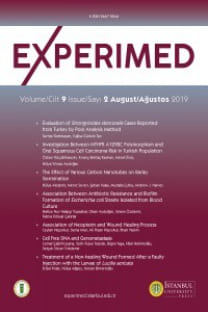B6D2F1 ve CB6F1 Irk Farelerde Kauda Epididimal Spermatozoa Kullanılarak İntrastoplazmik Sperm Enjeksiyonu (ICSI)
Intracytoplasmic Sperm Injection (ICSI) in B6D2F1 and CB6F1 Strains Mice Using Cauda Epididymal Spermatozoa
Mouse, oocyte, ICSI, development,
___
- 1. Andersen ML, Winter LM. Animal models in biological and bio-medical research-experimental and ethical concerns. An Acad Bras Cienc 2019; 91. [CrossRef] google scholar
- 2. Yanagimachi R. Intracytoplasmic injection of spermatozoa and spermatogenic cells: its biology and applications in humans and animals. Reprod Biomed Online 2005; 10(2): 247-88. [CrossRef] google scholar
- 3. Li MW, Willis BJ, Griffey SM, Spearow JL, Lloyd KC K. Assessment of three generations of mice derived by ICSI using freeze-dried sperm. Zygote 2009; 17(3): 239-51. [CrossRef] google scholar
- 4. Songsasen N, Leibo SP. Cryopreservation of mouse spermatozoa II. Relationship between survival after cryopreservation and os-motic tolerance of spermatozoa from three strains of mice. Cryo-biology 1997; 35: 255-69. [CrossRef] google scholar
- 5. Sztein JM, Farley JS, Mobraaten LE. In vitro fertilization with cryo-preserved inbred mouse sperm. Biol Reprod 2000; 63: 1774-80. [CrossRef] google scholar
- 6. Nishizono H, Shioda M, Takeo T, Irie T, Nakagata N. Decrease of fer-tilizing ability of mouse spermatozoa after freezing and thawing is related to cellular injury. Biol of Reprod 2004; 71: 973-8. [CrossRef] google scholar
- 7. Dandekar PV, Glass RH. Development of mouse embryos in vitro is affected by strain and culture medium. Gamete Res 1978; 17: 279-85. [CrossRef] google scholar
- 8. Ogonuki N, Mori M, Shinmen A, Inoue K, Mochida K, Ohta A, et al. The effect on intracytoplasmic sperm injection outcome of geno-type, male germ cell stage and freeze-thawing in mice. PLoS One 2010; 5(6): e11062. [CrossRef] google scholar
- 9. Wakayama T, Perry AC, Zuccotti M, Johnson KR, Yanagimachi R. Full-term development of mice from enucleated oocytes injected with cumulus cell nuclei. Nature 1998; 394, 369-74. [CrossRef] google scholar
- 10. Taskin AC, Kocabay A, Gül S, Caglar-Erkal K. Comparison of parthe-nogenetic oocyte activation in different mouse strains on in vitro development rate and quality. Vet Hekim Der Derg 2021; 92(1): 42-8. google scholar
- 11. Wang Y, Yamauchi Y, Wang Z, Zheng H, Yanagimachi R, Ward MA, et al. Both Cauda and Caput Epididymal Sperm Are Capable of Supporting Full-Term Development in FVB and CD-1 Mice. Dev Cell 2020; 55(6): 675-6. [CrossRef] google scholar
- 12. Mallol A, Santalo J, Ibanez E. Psammaplin a improves develop-ment and quality of somatic cell nuclear transfer mouse embryos. Cell Reprogram 2014;16(5): 392-406. [CrossRef] google scholar
- 13. Fernandez-Gonzalez R, Laguna R, Ramos-Ibeas P, Pericuesta E, Alcalde-Lopez V, Perez-Cerezales S, et al. Successful ICSI in Mice Using Caput Epididymal Spermatozoa. Front Cell Dev Biol 2019; 7: 346. [CrossRef] google scholar
- 14. Stein P and Schultz RM. ICSI in the mouse. Methods Enzymol 2010; 476: 251-62. [CrossRef] google scholar
- 15. Ohta H, Sakaide Y and Wakayama T. Age and substrain-dependent sperm abnormalities in BALB/c mice and functional assessment of abnormal sperm by ICSI. Hum Reprod 2009; 24(4): 775-81. [Cross-Ref] google scholar
- 16. Ogonuki N, Mori M, Shinmen A, Inoue K, Mochida K, Ohta A, et al. The effect on intracytoplasmic sperm injection outcome of geno-type, male germ cell stage and freeze-thawing in mice. PLoS One, 2010; 5(6): e11062. [CrossRef] google scholar
- 17. Kawase Y, Iwata T, Toyoda Y, Wakayama T, Yanagimachi R and Su-zuki H. Comparison of intracytoplasmic sperm injection for inbred and hybrid mice. Mol Reprod Dev 2001; 60(1): 74-8. [CrossRef] google scholar
- 18. Fernandez-Gonzalez R, Laguna R, Ramos-Ibeas P, Pericuesta E, Alcalde-Lopez V, Perez-Cerezales S, et al. Successful ICSI in Mice Using Caput Epididymal Spermatozoa. Front Cell Dev Biol 2019; 7: 346. [CrossRef] google scholar
- 19. Moreira PN, Giraldo P, Cozar P, Pozueta J, Jimenez A, Montoliu L, et al. Efficient generation of transgenic mice with intact yeast artificial chromosomes by intracytoplasmic sperm injection. Biol Reprod 2004; 71(6): 1943-7. [CrossRef] google scholar
- Yayın Aralığı: Yılda 3 Sayı
- Başlangıç: 2011
- Yayıncı: İstanbul Üniversitesi
Pınar KÖSEOĞLU, Gamze GÜVEN, Ebba LOHMANN, Haşmet HANAĞASI, Hakan GÜRVİT, Başar BİLGİÇ, İrem DİKER, Nihan ERGİNEL-UNALTUNA
Norepinefrin ve Östradiol Escherichia coli’nin Üremesini ve Mar Genlerinin Ekspresyonunu Etkiler mi?
Defne GÜMÜŞ, Fatma KALAYCI YÜKSEK, Özlem SEFER, Emre YÖRÜK, Gülşen UZ, A. Mine KÜÇÜKER
Ayşegül Başak AKADAM-TEKER, Erhan TEKER
Mehmet DEMİRCİ, Özge ÜNLÜ, Bekir KOCAZEYBEK
Yetişkin Lenfoid ve Miyeloid Malignitelerde LEF1 İzoformlarının Farklı Ekspresyonu
Sinem FIRTINA, Özden HATIRNAZ NG, Yücel ERBİLGİN, İbrahim Celaleddin HAZNEDAROĞLU, Müge SAYİTOĞLU
Türkiye’deki Pulicaria Türlerinin Antimikrobiyal Aktivitesi
Ebru ÖZDEMİR NATH, Merve BİLGİN, Bahar GURDAL
Dr. Ali Cihan TAŞKIN, Ahmet KOCABAY, Nilhan COŞKUN
Ömer Faruk DÜZENLİ, Beyza GÖNCÜ, Emrah YÜCESAN, Harika SALEPCİOĞLU, Yeliz Emine ERSOY, Adem AKÇAKAYA
